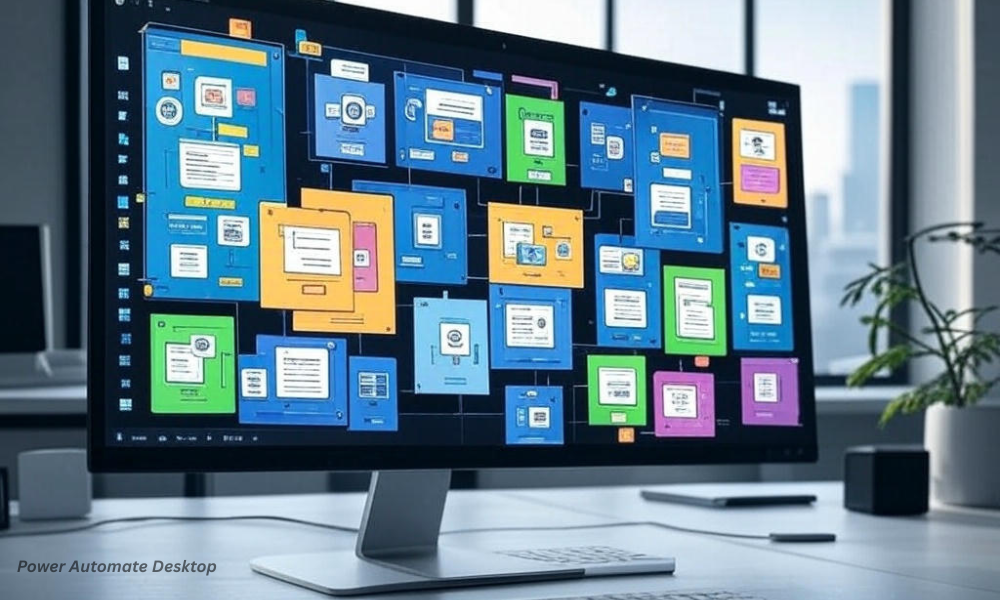Power Automate Desktop: What It Is, How It Works, and Why You Need It

Power automate desktop Let’s clear up the main question right away: Yes, you can use Power Automate Desktop—and it’s free for Windows 10 and 11 users. Whether you’re an individual, a business owner, or part of a large enterprise, this tool can help you automate repetitive tasks and save hours of your time.
In this guide, we’ll explore what Automate desktop tasks is, how to use it, why it matters, and how to make the most of it.
Table of Contents
What Is Power Automate Desktop?
Basic Overview
Power Automate Desktop is a powerful Robotic Process Automation (RPA) tool from Microsoft that allows users to automate manual, rule-based tasks across desktop and web apps.
How It’s Different from Cloud Power Automate
While Power Automate Cloud focuses on online flows using APIs and connectors, Power Automate Desktop works locally on your PC, allowing you to control apps, files, browsers, and more—just like a human would.
Can You Use Power Automate Desktop? (User Intent Answered Early)
Yes, It’s Free for Windows 10/11 Users
Microsoft made Power Automate Desktop completely free for all Windows 10 and 11 users. No licenses. No hidden fees.
Ideal for Personal and Business Automation
Whether you’re automating emails, file movements, or app interactions, this tool offers a fast and efficient solution.
Key Features of Power Automate Desktop
Desktop Flows
Create flows that automate your interactions with local software and web pages.
Recorder and Drag-and-Drop Interface
No coding needed. Just record your steps or drag actions from a library to build flows.
Pre-built Actions and Connectors
Hundreds of built-in actions to automate everything from Excel to Outlook to websites.
Integration with Other Microsoft Tools
It integrates seamlessly with Excel, Word, Outlook, Teams, and SharePoint, making it perfect for businesses already in the Microsoft ecosystem.
How to Install Power Automate Desktop
Download from Microsoft
Go to Microsoft’s official website or use the Microsoft Store to download Automate desktop tasks.
Step-by-Step Installation Guide
- Download the installer
- Run setup and follow prompts
- Sign in with your Microsoft account
- Start creating flows!
Getting Started: Building Your First Automation
Launching the App
Open Automate desktop tasks from your start menu.
Using the Recorder
Use the built-in recorder to track your clicks, keystrokes, and actions.
Creating and Saving a Flow
Edit the steps, test it, and click save. That’s it—you’ve built your first flow!
Real-World Use Cases
Automating Excel Reports
Open Excel, pull data, create charts, and email them—all hands-free.
Email Filtering and Responses
Sort incoming mail, flag important ones, and auto-reply using Outlook.
File and Folder Management
Move, copy, rename, or back up files based on conditions.
Web Data Extraction
Scrape content or prices from websites for research or reporting.
Power Automate Desktop vs Other Automation Tools
Comparison with UiPath
UiPath is more enterprise-focused, but Power Automate Desktop is more user-friendly for beginners.
Comparison with Zapier
Zapier is cloud-based and works best with APIs, while PAD shines on your desktop.
Best for Windows-Centric Workflows
If your tasks revolve around Windows, Power Automate Desktop is hard to beat.
Advantages of Power Automate Desktop
No Code Needed
Built for everyone—from office admins to power users.
Free and Accessible
Budget-friendly (as in zero cost) and easy to install.
Microsoft Ecosystem Integration
Works better when paired with other Microsoft services.
Limitations and Challenges
Learning Curve
It takes time to master complex flows, especially error handling.
Occasional Bugs or Glitches
As with any software, expect the occasional hiccup.
Requires Windows OS
Mac and Linux users will need alternatives.
Tips to Improve Workflow Automation
Use Modular Flows
Break large automations into smaller chunks for easier maintenance.
Test and Debug Often
Use the run and debug features to ensure everything works.
Leverage Community Templates
Explore Microsoft’s Power Automate gallery for pre-built flows.
How Secure Is Power Automate Desktop?
Data Protection Standards
All data stays local unless explicitly connected to cloud apps.
Enterprise-Grade Compliance
Supports enterprise-grade security protocols and user access control.
Who Should Use Power Automate Desktop?
Small Businesses
Save time and reduce labor costs without hiring developers.
Enterprise Teams
Scale automation with Microsoft 365 and centralized control.
Individual Users
Tackle boring daily tasks automatically—from form-filling to report generating.
Common Mistakes to Avoid
Overcomplicating Flows
Start simple. Don’t automate chaos—organize first.
Ignoring Logs and Errors
Always monitor your flow logs to catch bugs before they snowball.
Final Thoughts on Power Automate Desktop
Power Automate Desktop is a game-changer. It lets anyone—not just developers—automate repetitive tasks, save time, and reduce errors. The best part? It’s totally free for Windows users.
FAQs
Can I use it offline?
Yes. Desktop flows can run entirely offline unless they interact with web-based tools.
What skills do I need to use it?
None! It’s beginner-friendly with a visual drag-and-drop interface.
Can I automate web applications with it?
Absolutely. It supports web automation including data scraping and form submission.
What’s the difference between desktop and cloud flows?
Desktop flows run on your local machine. Cloud flows operate online and use APIs to connect apps.





